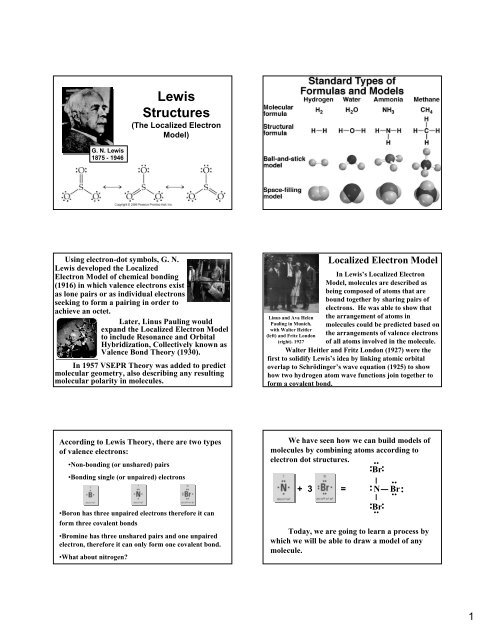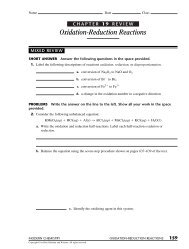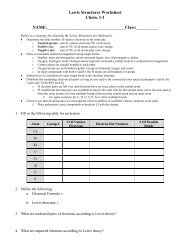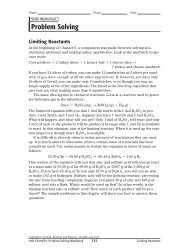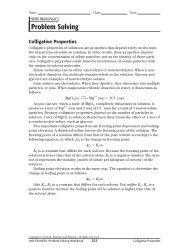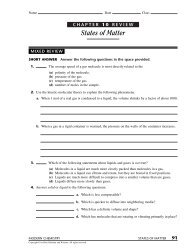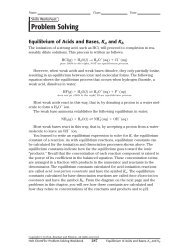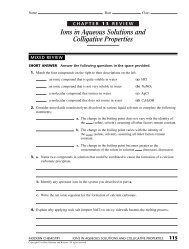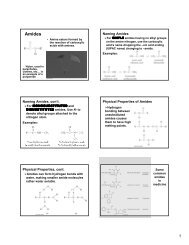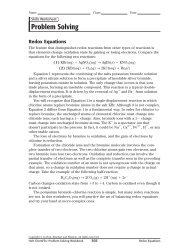L3 - Lewis Structures
L3 - Lewis Structures
L3 - Lewis Structures
Create successful ePaper yourself
Turn your PDF publications into a flip-book with our unique Google optimized e-Paper software.
<strong>Lewis</strong><strong>Structures</strong>(The Localized ElectronModel)G. N. <strong>Lewis</strong>1875 - 1946Using electron-dot symbols, G. N.<strong>Lewis</strong> developed the LocalizedElectron Model of chemical bonding(1916) in which valence electrons existas lone pairs or as individual electronsseeking to form a pairing in order toachieve an octet.Later, Linus Pauling wouldexpand the Localized Electron Modelto include Resonance and OrbitalHybridization, Collectively known asValence Bond Theory (1930).In 1957 VSEPR Theory was added to predictmolecular geometry, also describing any resultingmolecular polarity in molecules.Linus and Ava HelenPauling in Munich,with Walter Heitler(left) and Fritz London(right). 1927Localized Electron ModelIn <strong>Lewis</strong>’s Localized ElectronModel, molecules are described asbeing composed of atoms that arebound together by sharing pairs ofelectrons. He was able to show thatthe arrangement of atoms inmolecules could be predicted based onthe arrangements of valence electronsof all atoms involved in the molecule.Walter Heitler and Fritz London (1927) were thefirst to solidify <strong>Lewis</strong>’s idea by linking atomic orbitaloverlap to Schrödinger’s wave equation (1925) to showhow two hydrogen atom wave functions join together toform a covalent bond.According to <strong>Lewis</strong> Theory, there are two typesof valence electrons:•Non-bonding (or unshared) pairs•Bonding single (or unpaired) electrons•Boron has three unpaired electrons therefore it canform three covalent bonds•Bromine has three unshared pairs and one unpairedelectron, therefore it can only form one covalent bond.•What about nitrogen?We have seen how we can build models ofmolecules by combining atoms according toelectron dot structures. .. : Br :..+ 3 = : N Br .. :: Br.. :Today, we are going to learn a process bywhich we will be able to draw a model of anymolecule.1
<strong>Lewis</strong> <strong>Structures</strong>Writing <strong>Lewis</strong> <strong>Structures</strong><strong>Lewis</strong> structures arerepresentations of moleculesshowing all electrons, bondingand nonbonding.PCl 35 + 3(7) = 261. Find the sum ofvalence electrons of allatoms in the moleculefrom the groupnumber or electrondot structure.Writing <strong>Lewis</strong> <strong>Structures</strong>Keep track ofthe electrons:26 − 6 = 202. Build a reasonableskeletal structure forthe molecule usingonly single bonds. The central atomshould be the leastelectronegativeelement that isn’thydrogen.Writing <strong>Lewis</strong> <strong>Structures</strong>Keep track ofthe electrons:26 − 6 = 20• Things to consider whenbuilding primary skeleton: Oxygen never bonds to itself,except in O 2 and O 3 Carbon atoms are usuallybonded to each other In molecules containing both Hand O, hydrogen is usuallybonded to oxygen Carbons should always besaturated with hydrogens whenpossibleWriting <strong>Lewis</strong> <strong>Structures</strong>Writing <strong>Lewis</strong> <strong>Structures</strong>Keep track of theelectrons:26 − 6 = 20 − 18 = 23. Subtract the totalnumber ofelectrons used inthe primary bondsfrom the availablevalence electrons.4. Fill the octets of theouter atoms byadding unsharedpairsKeep track of the electrons:26 − 6 = 20 − 18 = 2 − 2 = 05. Fill the octet ofthe central atom.6. Check to see thatall atoms haveand octet andthat the correctnumber ofvalence electronswere used2
Writing <strong>Lewis</strong> <strong>Structures</strong>Writing <strong>Lewis</strong> <strong>Structures</strong>7. If you run out of electrons before thecentral atom has an octet…Example:Try building a <strong>Lewis</strong> structure for HCN5. …form multiple bondsuntil it does.1. Let’s try drawing the <strong>Lewis</strong> <strong>Structures</strong>for the following molecules:A. Carbon tetrachlorideB. AmmoniaC. OxygenD. Carbon dioxideE. Dihydrogen carbon monoxideF. Ethanal (C 2 H 4 O)•Polyatomic ions are formed from a class ofmolecules called Acids, or in some rare cases,from Bases.•Polyatomic ions are formed as acids or basesloose or gain hydrogen atoms.HydrogennitrateFor example:NO 3-nitrate ionHydrogen nitrate looses a hydrogen proton when placed inwater, resulting in the formation of the nitrate ion (notice the1- charge)2. Let’s draw the <strong>Lewis</strong> structure fordihydrogen sulfate and for thesulfate anion formed whendihydrogen sulfate is placed inwater.•<strong>Lewis</strong> structures for polyatomic ionsmust account for the loss or gain ofvalence electronsCations – decrease valence electronsby amount of chargeAnions – increase valence electronsby amount of charge•<strong>Lewis</strong> structures for polyatomic ionsare written in brackets [ ] with thecharge denoted as a superscript.3
3.Try drawing the <strong>Lewis</strong> structure forhydrogen nitrate and the nitrate ion.4. Draw the <strong>Lewis</strong> Structure forozone, O 3 .You may notice more than one <strong>Lewis</strong> structurecan be drawn for these species.Notice that two L.S. can be drawncorrectly for ozone, O 3RESONANCEResonance theory, developed by <strong>Lewis</strong> (1928), is akey component of valence bond theory and ariseswhen no single conventional model using only evennumber of electrons shared exclusively by twoatoms can actually represent the observedmolecule. Resonance involves modeling thestructure of a molecule as an intermediate, oraverage, between several simpler but incorrectstructures.Resonance• One <strong>Lewis</strong> structure cannot accuratelydepict a molecule such as ozone.• We use multiple structures, resonancestructures, to describe the molecule.• Resonance is denoted by a double headedarrow separating the different <strong>Lewis</strong><strong>Structures</strong>:Resonance• But this is at oddswith the true,observed structureof ozone, inwhich……both O—Obonds are thesame length.Resonance• In truth, the electrons that form the second C—Obond in the double bonds below do not always sitbetween that C and that O, but rather can moveamong the two oxygens and the carbon.• They are not localized, but rather are delocalized.4
ResonanceJust as green is asynthesis of blue andyellow…• Observe HCO 2- :Resonance…ozone is asynthesis of thesetwo resonancestructures.• In truth, the electrons that form the second C—Obond in the double bonds below do not always sitbetween that C and that O, but rather can moveamong the two oxygens and the carbon.• They are not localized, but rather are delocalized.5. Draw all three resonance structuresfor the nitrate ion.5


